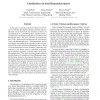8 search results - page 1 / 2 » Manifold Learning-Based Feature Transformation for Phone Cla... |
75
Voted
NOLISP
2007
Springer
15 years 6 months ago
2007
Springer
ICASSP
2010
IEEE
15 years 15 days ago
2010
IEEE
Class posterior distributions have recently been used quite successfully in Automatic Speech Recognition (ASR), either for frame or phone level classification or as acoustic featu...
100
click to vote
CVPR
2008
IEEE
15 years 2 months ago
2008
IEEE
In this paper, we develop a geometric framework for linear or nonlinear discriminant subspace learning and classification. In our framework, the structures of classes are conceptu...
115
click to vote
ECCV
2010
Springer
15 years 4 months ago
2010
Springer
Sparse coding of sensory data has recently attracted notable attention in research of learning useful features from the unlabeled data. Empirical studies show that mapping the data...
106
click to vote
ICMCS
2008
IEEE
15 years 6 months ago
2008
IEEE
A two-stage cascaded classification approach with an optimal candidate selection scheme is proposed to recognize places using images taken by camera phones. An optimal acceptance ...

